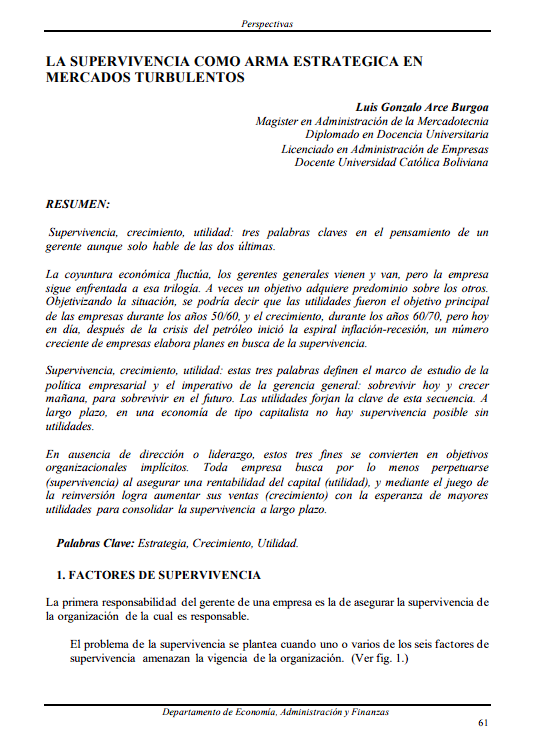Survival as a strategic weapon in turbulent markets.
DOI:
https://doi.org/10.35319/e9bymt61Keywords:
Strategy, Growth, ProfitAbstract
Survival, growth, profit: three key words in a manager’s thinking even if they only talk about the last two. The economic situation fluctuates, general managers come and go, but the company continues to face this trilogy. Sometimes one objective takes precedence over the others. Objectively speaking, it can be said that profits were the main goal of companies during the 1950s/60s, and growth during the 1960s/70s, but today, after the oil crisis began the inflation-recession spiral, an increasing number of companies develop plans in search of survival. Survival, growth, profit: these three words define the framework for studying business policy and the imperative of general management: survive today and grow tomorrow to survive in the future. Profits forge the key to this sequence. In the long term, in a capitalist economy, survival is not possible without profits. In the absence of direction or leadership, these three aims become implicit organizational objectives. Every company seeks at least to perpetuate itself (survival) by ensuring a return on capital (profit), and through reinvestment, it manages to increase its sales (growth) with the hope of greater profits to consolidate long-term survival.
Downloads
References
Aasel, Henry (1993). Marketing: Principios y estrategias. U.S.A.
Bateman, Thomas y Snell, Scout (1999). Administración: Una ventaja competitiva. 4ª edición. México: McGraw-Hill.
Bermejo, Manuel (2003). Crea tu propia empresa: Estrategias para su puesta en marcha y supervivencia. España: McGraw-Hill.
Bueno Campos, Eduardo (1993). Dirección estratégica de la empresa: Metodología, técnicas y casos. 3ª edición. España: Pirámide.
Díez de Castro, Emilio Pablo (2001). Administración y dirección. 1ª edición. España: McGraw-Hill.
David, Fred R. (2003). Conceptos de administración estratégica. 9ª edición. México D.F.: Pearson.
Guías de Gestión de la Pequeña Empresa (1997). La ventaja competitiva. España: Díaz de Santos S.A.
Hermida, Jorge, Serra, Roberto y Katika, Eduardo (1998). Administración y estrategia: Un enfoque competitivo y emprendedor. 1ª edición. Argentina: Macchi.
Hermida, Jorge y Serra, Roberto (2001). Administración y estrategia. 2ª edición. Argentina: Macchi.
Ivancevich, John M. (1997). Gestión, calidad y competitividad. España: McGraw-Hill.
Kami, Michael J. (1990). Puntos estratégicos. 1ª edición. Bogotá: McGraw-Hill.
Kaplan, R. y Kaplan, D. (2004). Mapas estratégicos. 1ª edición. España: Editorial 2000.
Kotler, Philip (2001). Dirección de marketing: La edición del milenio. México: Prentice Hall.
Kotler, Philip y otros (2001). Introducción al marketing. 2ª edición europea. España: Prentice Hall.
Kotler, Philip y Armstrong, Gary (1998). Fundamentos de mercadotecnia. 4ª edición. México: Prentice Hall.
Shoell, William T. y Guiltinan, Joseph P. (1995). Marketing. 6ª edición. New Jersey: Prentice Hall.
Soto Pineda, Eduardo (2004). Las PYMES ante el retorno del siglo XXI: Los nuevos mercados globales. 1ª edición. México: Thomson.
Thompson Jr., A. A. y Strickland III, A. J. (2003). Administración estratégica. 13ª edición. México D.F.: McGraw-Hill.
Thompson, Arthur A. y Strickland, A. J. (2001). Administración estratégica: Conceptos y casos. 11ª edición. México: McGraw-Hill.
Vázquez, Jorge Rubén (2003). Dirección eficaz de PyMEs. 1ª edición. Argentina: Macchi.
Wischñvsky, Amalia y Zaina, Alicia (1994). ¿A qué juegan las palabras?: Estrategias para la creatividad lingüística. Argentina: Magisterio del Río de La Plata.
Zevallos, Emilio y Velazco, Enrique (2003). Construyendo el desarrollo a través de las PYMES: La experiencia boliviana. Bolivia: Fundes Internacional.

Downloads
Published
Issue
Section
License
Copyright (c) 2007 Revista Perspectivas

This work is licensed under a Creative Commons Attribution-NonCommercial-ShareAlike 4.0 International License.
La Revista Perspectivas de la Universidad Católica Boliviana, es una revista de acceso abierto, por lo tanto, es de libre acceso en su integridad. Está permitida su lectura, búsqueda, descarga, distribución y reutilización legal en cualquier tipo de soporte únicamente para fines no comerciales, siempre y cuando la obra sea debidamente citada.




